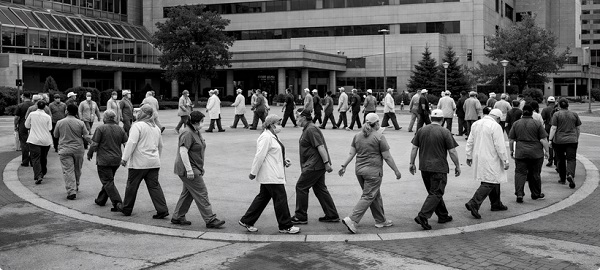MAiD
Assisted suicide is never really about ‘choice’: here’s why

From LifeSiteNews
Just a few years ago, we understood that suicidal ideation itself was an indication that something was seriously wrong – but our euthanasia regime has changed all of that.
Just last week, I wrote a column on the normalization of euthanasia and the sinister insistence by those who advocate for it that being killed by lethal injection is, in fact, both a good and a life-saving thing. We are seeing the complete perversion of language in order to justify medicalized killing, which is why you don’t read terms like “killing” or “suicide” in the context of the euthanasia debate in the press. Activists realized very quickly that these terms were unhelpful in the push for normalization.
Earlier this month, Canadian MP Kevin Lamoureux, a Liberal, took it a step further, stating: “MAiD [assisted suicide] legislation, even on occasion, I would ultimately argue, saves lives.”
🤯🤯🤯🤯🤯🤯🤯🤯 pic.twitter.com/bFU57gKxCJ
— Michelle Ferreri (@mferreriptbokaw) February 12, 2024
What a truly insane thing to say – and the sad fact is, he likely believes it. He also likely doesn’t realize how dangerous his statement is. What message is being sent to those the government has deemed eligible for state-facilitated suicide? Euthanasia is, legally speaking, a choice. But just as with abortion, the “choice” is often a farcical one.
When women were legally granted the “choice” of abortion, it swiftly became an expectation. Sick, sad, and depressed people may be told they merely have the “choice” to be euthanized – but as we have seen, this choice often seems like a social obligation.
This point was made in a recent essay about euthanasia in Newsweek by Katherine Brodsky, who supports euthanasia in principle. She has, however, come to have doubts that a euthanasia regime in which choice is freely exercised is possible. She writes:
I am now skeptical about the true autonomy of individuals opting for assisted death, especially in a country with socialized health care. The risk of medical practitioners recommending MAiD as a cost-cutting measure to alleviate strain on the health care system is unsettling, as suggested by a 2020 analysis estimating potential annual savings of save $66 million annually in health care costs. Individuals considering MAiD are already vulnerable due to physical or mental suffering, making them susceptible to external pressures. Reflecting on my own past struggles, I recognize the unpredictability of emotions and circumstances. What seems unbearable one day may change with time and support – yet the choice to end life is a permanent one.
Fortunately, the Canadian government has delayed – for the second time – expanding euthanasia to those suffering from mental illness. But they insist that this is a delay, not a cancellation, meaning that the position of the Trudeau government is that someone suffering acute despair caused by a mental illness is clear-headed enough to choose suicide-by-doctor. This is obviously untrue, and I genuinely wonder why the government seems so hellbent on doing this. Just a few years ago, we understood that suicidal ideation itself was an indication that something was seriously wrong – but our euthanasia regime has changed all of that.
Brodsky notes that the “choice” being offered to a specific subset of Canadians who have been pre-approved for this “choice” – a choice not offered to all Canadians, but only those the government has decided have lives not worth living – is often a false one. Citing the example of Lauren Hoeve, the Dutch girl who was euthanized earlier this year, she notes:
And yet, I was struck by something in the statement put out by Lauren Hoeve’s parents. ‘Millions of people are affected by ME/CFS, with no established treatment pathways and no cure,’ they wrote on X on Feb. 2. ‘Why is their suffering acknowledged enough for euthanasia but not enough to fund clinical research?’ And herein lies the rub. Why is euthanasia offered as a viable solution to a potentially non-permanent problem, when other options are possible?
Mental health services in Canada (and elsewhere) are scarce. Psychologists are expensive and out of reach for many. Psychiatric services are free of charge, but the wait lists are even longer than those for psychologists and few people can get access. The wait to get help is usually over a year. Family physicians just end up prescribing medications based on a checklist and see what sticks.
READ: Terminally ill children in the Netherlands can now be euthanized against their will
Precisely true. We know that many people in Canada have chosen euthanasia because it was the only “choice” being offered to them at all. Cancer patients who cannot get the treatment they actually want have opted for suicide-by-doctor instead. One woman noted that her requests for additional help to deal with her chronic condition were denied, and thus euthanasia was, she felt, the only option left available. “Ultimately it was not a genetic disease that took me out, it was a system,” she wrote. “There is desperate need for change. That is the sickness that causes so much suffering. Vulnerable people need help to survive. I could have had more time if I had more help.”
So, what does an ill and suffering Canadian hear when an MP stands up in the House of Commons and says that euthanasia “saves lives”? They know it doesn’t save their life. As Amanda Achtman noted: “Obviously, it’s not the lives of those being killed that are being saved. Such a utilitarian calculation amounts to a war against the weak and this is dehumanizing and wrong.”
Great Reset
Viral TikTok video shows 7-year-old cuddling great-grandfather before he’s euthanized

From LifeSiteNews
Karly Vavra, the little girl’s mother, told People that she chose to share the video in order to honor her grandfather—but also to normalize euthanasia.
A video of a 7-year-old girl sharing a “final cuddle” with her great-grandfather before he is euthanized has gone viral on TikTok, racking up millions of views.
@karlsbergggg Sobbing 😭 #MAID #medicallyassisteddeath #grandpasgirl #greatgrandpa #greatgrandparents
The video shows the child curled up next to an elderly man, sitting straight on the couch, their final moments together captured. “This is my 96 year old grandpa with my 7 year old,” the caption reads. “He’s doing MAID soon. I tried explaining gently to my daughter that this was the last visit she’d have with him. This is what she did the second she walked in. He’s so happy.”
Karly Vavra, the little girl’s mother, told People that she chose to share the video in order to honor her grandfather—but also to normalize euthanasia. “The feeling is very bittersweet,” she said. “I look back with smiles and tears.” She admitted that she knows “my daughter didn’t fully understand these were her last moments with him.”
Her grandfather, who had chosen euthanasia, did understand the gravity of the moment. “My grandpa knew those were his last moments with her,” Vavra said. “Him looking down in that short moment, I believe, was his way of trying to hide emotions as he was a very proud man.” Her grandfather was scheduled to be killed by lethal injection just days later.
READ: Glenn Beck offers to fund life-saving surgery for Canadian woman approved for euthanasia
Vavra says her grandfather was always a favorite of neighborhood children, who were drawn to him. “I am so grateful both my kids got to know him, though, as not many children get [much] time, if any, with a great grandparent,” she said. “My grandpa was honestly the sweetest man. He loved children, gardening, golf, music and was VERY opinionated… Him and my kids were always laughing with each other, and he loved how loud and proud my daughter was! I hope she is strong like he was and always laughs and sees the brighter side.”
Vavra posted the video because she wanted to celebrate her grandfather’s euthanasia. “I posted this because I truly believe MAID can be a wonderful thing,” she told People. “Letting people go the way they want, with dignity, and not suffering… A lot of religions don’t believe in MAID and some comments were more aggressive than others. Seeing how negative some of the responses were made me really want to advocate for the MAID program.”
“Her connection to MAID began long before her own grandparents made their decisions, as she previously worked on a case in British Columbia after she says many of her coworkers opted not to participate,” People reported.
“I am a very open, understanding person and believe in ‘your body your choice’ which is why I volunteered,” she says...This year alone brought unimaginable loss for her family. “My parents and aunt have had a harder time because both their mom and dad decided to do MAID this year, so it’s definitely been a rough year, but we are sticking together as a family and really trying to cherish all our moments together,” Karly shares.
There are over 10,000 comments on Vavra’s TikTok video, many of them expressing horror at the normalization of putting elderly people to sleep like sick household pets.
“I always try to be honest with my children,” Vavra said. “I explained that Big Papa (what my kids called him) was in a lot of pain and that he would be going to meet Big Grandma on Saturday (my grandma also did MAID this year). I explained that a very nice doctor and nurses were coming and they were going to give him some medicine and he would fall into the best sleep ever but forever, and that he wouldn’t be in pain anymore.”
It is notable that despite the irreligious basis of euthanasia, spiritual language is often incorporated into euthanasia conversations in order to soften the reality of what is taking place.
This is a new Canadian reality: Children losing their parents, grandparents, and great-grandparents not to natural death, but to lethal injections. Their goodbyes are defined by moments that do not have to be the last but have been chosen. There could have been more conversations. More cuddles. More love. But there was not—and that was a decision. “Seeing her link arms with him was very touching but of course very painful,” Vavra said. “Both loving each other so much. I wish we could have had him forever.”
They could have had him longer.
International
Trump admin wants to help Canadian woman rethink euthanasia, Glenn Beck says

From LifeSiteNews
Jolene Van Alstine, approved for state-sanctioned euthanasia after enduring long wait times to receive care for a rare parathyroid disease, is in need of a passport to enter the U.S.
Well-known American media personality Glenn Beck says he has been in touch with the U.S. State Department to help a Canadian woman in Saskatchewan reconsider euthanasia after she sought assisted suicide due to long medical wait times to address her health problems.
As reported by LifeSiteNews on Tuesday, Canadian woman Jolene Van Alstine was approved to die by state-sanctioned euthanasia because she has had to endure long wait times to get what she considers to be proper care for a rare parathyroid disease.
Van Alstine’s condition, normocalcemic primary hyperparathyroidism (nPHPT), causes her to experience vomiting, nausea, and bone pain.
Her cause caught the attention of Beck and many other prominent Americans and Canadians on X.
In an update today on X, Beck said, “Jolene does not have a passport to gain legal entry into the U.S., but my team has been in touch with President (Donald) Trump’s State Department.”
“All I can say for now is they are aware of the urgent life-saving need, and we had a very positive call,” he added.
Beck had said before that he was in “contact with Jolene and her husband” and that he had “surgeons who emailed us standing by to help her.”
As of press time, neither the State Department nor other officials have not yet confirmed Beck’s claim that he has been in touch with them.
As a result of Van Alstine’s frustrations with the healthcare system, she applied for Canada’s Medical Assistance in Dying (MAiD) and was approved for January 7.
As reported by LifeSiteNews, over 23,000 Canadians have died while on wait lists for medical care as Prime Minister Mark Carney’s Liberal government is focused on euthanasia expansions.
A new Euthanasia Prevention Coalition report revealed that Canada has euthanized 90,000 people since 2016, the year it was legalized.
As reported by LifeSiteNews recently, a Conservative MP’s private member’s bill that, if passed, would ban euthanasia for people with mental illness received the full support of the Euthanasia Prevention Coalition.
-

 Business2 days ago
Business2 days agoDisclosures reveal Minnesota politician’s husband’s companies surged thousands-fold amid Somali fraud crisis
-

 Alberta2 days ago
Alberta2 days agoThe Canadian Energy Centre’s biggest stories of 2025
-

 Business2 days ago
Business2 days agoResurfaced Video Shows How Somali Scammers Used Day Care Centers To Scam State
-

 Business19 hours ago
Business19 hours agoThe Real Reason Canada’s Health Care System Is Failing
-

 Business2 days ago
Business2 days agoMinneapolis day care filmed empty suddenly fills with kids
-

 Business2 days ago
Business2 days agoOttawa Is Still Dodging The China Interference Threat
-

 Business18 hours ago
Business18 hours agoFederal funds FROZEN after massive fraud uncovered: Trump cuts off Minnesota child care money
-

 Opinion10 hours ago
Opinion10 hours agoGlobally, 2025 had one of the lowest annual death rates from extreme weather in history





